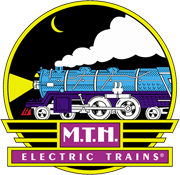Product Spotlight - Premier 2-8-8-8-2 Triplex Steam Engine
Available Items
20-3614-1
- Virginian

P. T. Barnum would have loved the Triplex. It was an engine of superlatives: more drivers than anything before or since, too big for the shops of its owner, the Erie Railroad, powerful enough to pull a train nearly five miles long. Ninety years ago, in the days before multiple-unit control allowed one throttle to control several locomotives, the Triplex was the ultimate attempt to put as much power as possible in the hands of a single engineer. In the end, it proved a noble, flamboyant, but less-than-successful experiment. Baldwin Locomotive Works built three triplexes between 1914 and 1916 for pusher service on the Erie Railroad's daunting Susquehanna Hill (also known as Gulf Summit) near Deposit, N.Y. The cylinders of the Triplex's middle engine were powered by high pressure steam direct from the boiler, while the front and rear engines used low pressure steam exhausted from the middle cylinders.
Each triplex replaced three ordinary helper engines, and the new locomotives worked well enough to stay on the Erie roster for more than a decade. But the design proved a bit over the top and only one more Triplex was ever built, for the Virginian Railway. Even with their huge boilers, the locomotives could only make enough steam to go 10 mph. One reason was poor draft in the firebox, because only the front cylinders exhausted through the smokebox and created draft; the rear cylinders exhausted through a separate smokestack on the tender. Another inherent problem with the design was that traction from the rear engine decreased as the boiler used coal and water and the tender got lighter.
Returning to the M.T.H. lineup for 2015, the Premier Triplex recreates the sound, the smoke, and the flamboyance of the original design - but runs much better than the prototype ever did. Only MTH engineering could make such a complex model run smoothly and steadily at speeds from a barely perceptible crawl to wide-open throttle. Add the Triplex to your roster and experience the sheer visual drama of one of the grand experiments in early twentieth century heavy machinery.
Did You Know?
The Triplex was engineered to haul 640 fifty-ton cars in a train almost five miles long. But the couplers and draft gear of the early twentieth century could not have handled such a load, so the 2-8-8-8-2 was used as a pusher and never put to a full test.
Product Features
Product Features:
- Intricately Detailed, Die-Cast Boiler and Chassis
- Intricately Detailed, Die-Cast Tender Body
- Authentic Paint Scheme
- Real Tender Coal Load
- Die-Cast Locomotive Trucks
- Handpainted Engineer and Fireman Figures
- Metal Handrails, Whiste and Bell
- Metal Wheels and Axles
- Remote Controlled Proto-Coupler
- Prototypical Rule 17 Lighting
- Constant Voltage LED Headlight
- Operating LED Firebox Glow
- Operating LED Marker Lights
- Lighted LED Cab Interior
- Operating Tender LED Back-up Light
- Powerful 7-Pole Precision Flywheel-Equipped Motor
- Synchronized Puffing ProtoSmoke System
- Locomotive Speed Control In Scale MPH Increments
- 1:48 Scale Dimensions
- Onboard DCC/DCS Decoder
- Proto-Sound 3.0 With The Digital Command System Featuring: Quillable Whistle With Freight Yard Proto-Effects
- Unit Measures:27 1/4” x 3” x 4 1/4”
- Operates On O-72 Curves
Steam DCC Features
- F0 Head/Tail light
- F1 Bell
- F2 Horn
- F3 Start-up/Shut-down
- F4 PFA
- F5 Lights (except head/tail)
- F6 Master Volume
- F7 Front Coupler
- F8 Rear Coupler
- F9 Forward Signal
- F10 Reverse Signal
- F11 Grade Crossing
- F12 Smoke On/Off
- F13 Smoke Volume
- F14 Idle Sequence 3
- F15 Idle Sequence 2
- F16 Idle Sequence 1
- F17 Extended Start-up
- F18 Extended Shut-down
- F19 Labor Chuff
- F20 Drift Chuff
- F21 One Shot Doppler
- F22 Coupler Slack
- F23 Coupler Close
- F24 Single Horn Blast
- F25 Engine Sounds
- F26 Brake Sounds
- F27 Cab Chatter
- F28 Feature Reset











